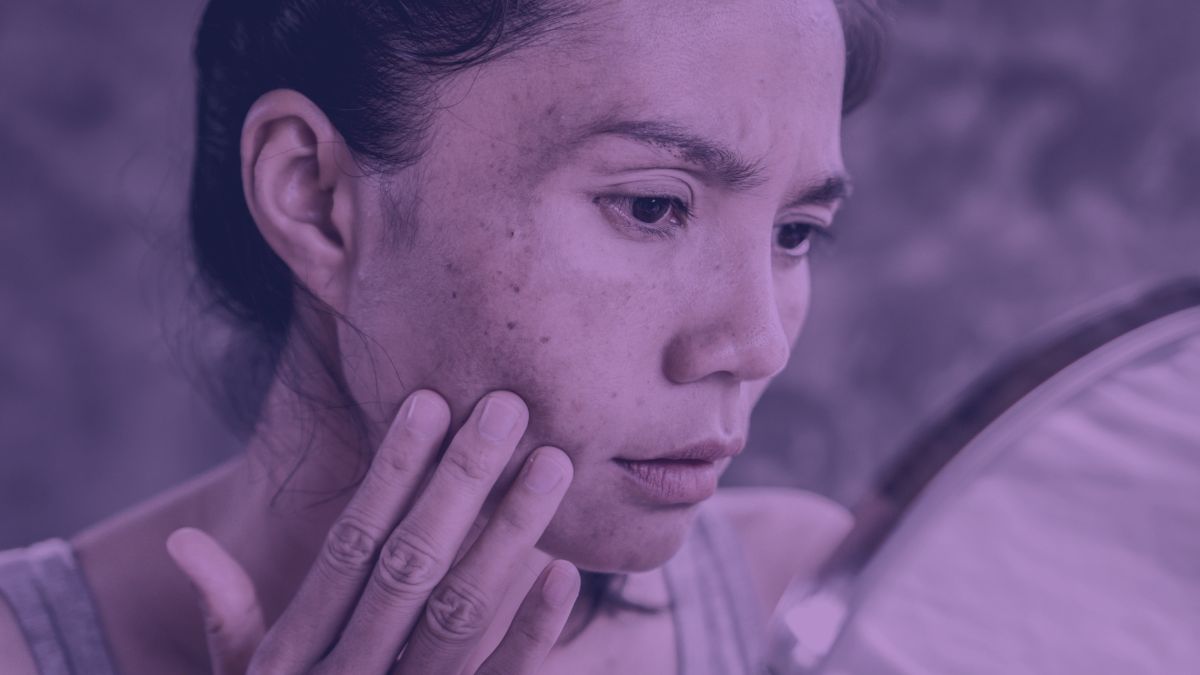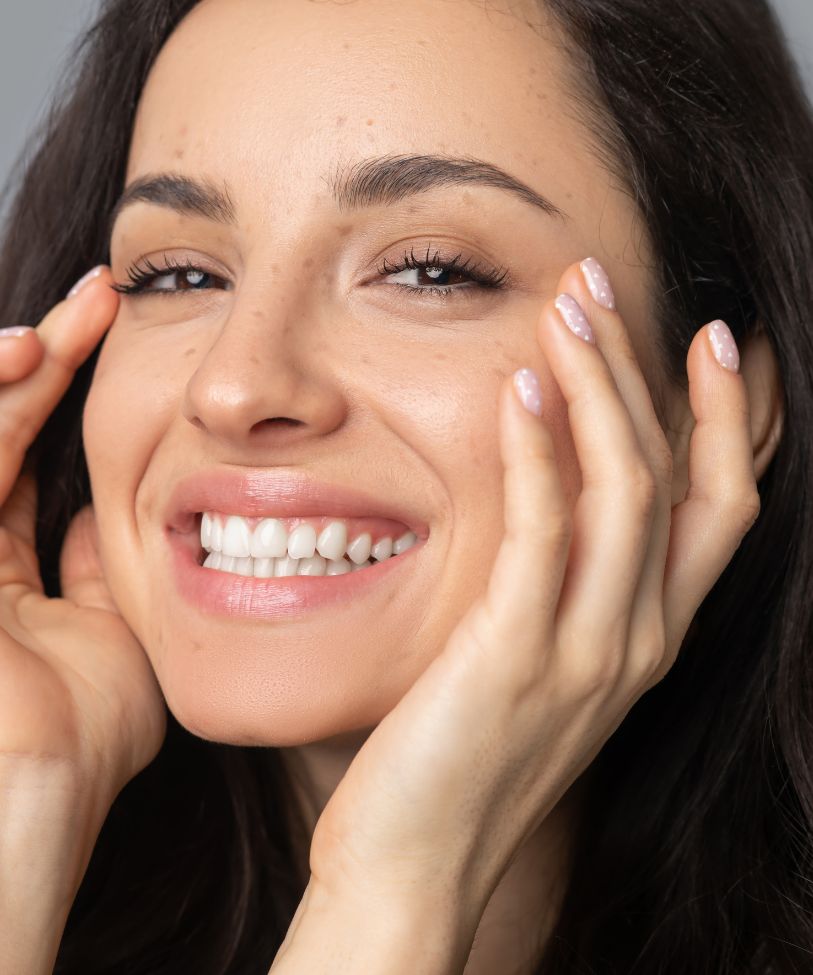Tretinoin is most commonly prescribed for inflammatory skin conditions such as acne and concerns like signs of aging.
However, despite being known for treating these two common skin concerns, tretinoin also has great potential to help with hyperpigmentation.
So, from what type of hyperpigmentation does tretinoin address to how long does it take to work for dark spots to fade, let’s dive into the evidence and answer some of the most common questions surrounding tretinoin and hyperpigmentation.

What is Tretinoin?
Tretinoin is a generic name for a topical medication derivative of vitamin A also known as all-trans retinoic acid, and is commonly prescribed to address various skin concerns in the form of a gel or cream.
Once applied to the skin, tretinoin will travel deeper into the epidermis and bind to specific receptors in the nucleus of cells, which are involved in gene expression and cell differentiation.
This leads to changes in gene expression, causing immature cells to differentiate into mature ones and develop specific functions, such as collagen production for skin repair and renewal.
Additionally, tretinoin also “teaches” the skin cells to behave in a “younger” way, which means they will renew themselves quicker and travel to the skin’s surface faster, resulting in a clearer, brighter, and more uniform complexion.
All-trans retinoic acid is commonly used in the treatment of acne, but it is a well-researched anti-aging component that has been shown effective in addressing concerns such as photoaging, hyperpigmentation, as well as deeper lines and wrinkles due to its ability to promote cellular turnover and aid in collagen synthesis.
Does Tretinoin Work for Hyperpigmentation?
Tretinoin lightens hyperpigmentation by increasing cellular turnover, which encourages the shedding of the top layer of pigmented skin cells and reveals new, healthy skin cells from underneath.
In simpler terms, tretinoin will shed the hyperpigmented skin layer over time until evenly pigmented skin cells replace them.
Furthermore, tretinoin also causes a dispersion of the melanin granules in the epidermis, which means the brown pigment clusters that contribute to hyperpigmentation will become more evenly distributed throughout the surface skin layer, resulting in an even-looking skin tone.
Finally, tretinoin, or retinoic acid, the main active ingredient in the product, also exhibits antioxidant properties, which means it can protect the skin from further skin damage caused by free radicals, which can worsen hyperpigmentation.
Overall, tretinoin improves the appearance of hyperpigmentation on the skin in several ways; therefore, it is definitely something you want in your arsenal when dealing with this pesky skin concern.
How to Use Tretinoin for Hyperpigmentation?

For best results when dealing with hyperpigmentation, start by applying a pea-sized amount of tretinoin all over your face every other night and slowly increase the frequency to once daily as tolerated.
It’s important only to increase the frequency if your skin can tolerate the product, as increasing too quickly can cause redness, dryness, peeling, flaking, and irritation.
Additionally, avoid using tretinoin as a spot treatment, as the results won’t be as good since one of the ways tretinoin fades hyperpigmentation is by dispersing the brown pigment causing the concern throughout the skin.
This means that if you only apply it on the affected area, it will be difficult for it to disperse the pigment evenly, which won’t get as close to even out the skin tone as desired.
It’s also worth mentioning that tretinoin should never be used alongside other retinoids such as adapalene or tazarotene, and it also shouldn’t be mixed or used in the same routine along with products containing exfoliating acids such as AHAs, BHAs, PHAs, and enzymes, as this will further irritate the skin and cause discomfort.
Finally, since tretinoin can increase the skin’s sensitivity to the sun and accelerate sunburns, it’s important to use sunscreen in the morning as soon as you start incorporating tretinoin into your evening skincare routine.
Using sunscreen will also prevent the hyperpigmented spots from deepening and becoming more challenging to get rid of since the UV rays can increase uneven melanin production by causing the surrounding skin to tan and making the hyperpigmented spots look darker in comparison.
Can Tretinoin be Used for All Types of Hyperpigmentation?
Tretinoin has been proven effective in fading all types of hyperpigmentation, from UV damage and sun spots to post-inflammatory hyperpigmentation that’s usually the result of healed acne and has even helped improve the appearance of hormonal conditions such as melasma, as per multiple randomized studies.
Therefore, it’s safe to say that tretinoin can be an effective treatment for all types of hyperpigmentation and is generally a much gentler option than other more aggressive treatments for hyperpigmentation, such as high-strength chemical peels and hydroquinone, a bleaching agent that can cause severe side effects and permanent loss of pigment and has even been banned in some countries.
Can Tretinoin Make Hyperpigmentation Worse?
In some cases, tretinoin can make hyperpigmentation worse before it gets better.
This is because the increased cell turnover and skin shedding that tretinoin promotes can cause the underlying pigmentation to come to the surface more quickly, leading to a temporary darkening or “purging” of the skin.
This is usually a sign that the treatment is working, and the hyperpigmentation should gradually fade with the continued use of tretinoin.
However, there are instances where hyperpigmentation can keep getting worse the longer tretinoin is used, and this doesn’t have much to do with tretinoin itself but is usually the result of using it incorrectly.
Here are some examples of incorrect tretinoin use that can lead to exacerbated hyperpigmentation:
- Using tretinoin more frequently instead of allowing the skin to adjust to it over time can result in inflammation and prolonged healing, and even new hyperpigmentation to form in the areas where the skin sheds the most.
- Not following up with a moisturizer can result in excessive dryness and shedding, thus worsening existing hyperpigmentation and triggering new pigmented spots.
- Not using sunscreen in the morning can result in natural tanning, which will make the hyperpigmented areas appear even darker than the surrounding skin.
- Using exfoliating acids along with tretinoin can cause the skin to shed and new pigmented spots to form.
Therefore, it’s important to use tretinoin correctly and not only follow the instructions on the package but also listen to your skin and take signs such as excessive dryness, redness, peeling, and flaking as warnings that the product may be too harsh for your skin and that you may need to pause using it or tailor your skincare routine to your specific skin needs, such as switching to a heavier moisturizer, incorporating a hydrating toner, a skin-soothing serum, etc.
How Often Should I Apply Tretinoin for Hyperpigmentation?
The goal frequency for using tretinoin is once a day as part of your evening routine.
This is how tretinoin will give the best results and improve even the most stubborn skin concerns, such as hyperpigmentation.
However, since tretinoin contains a strong active ingredient that demands the skin to adjust to its potency, it’s safe to say that you won’t be able to start using it every night right away.
For best results and minimal discomfort, start by applying tretinoin every 72 hours, as this is how long the retinization process usually lasts, so allowing anything longer than that between applications will only trigger your skin to react to the active ingredient more intensely and stay in that loop for longer.
Once your skin tolerates tretinoin better and the symptoms such as redness, dryness, flaking, and irritation have subsided, you can up the frequency to every 48 hours before eventually aiming for daily application.
Remember that treating hyperpigmentation can be a long and challenging process that requires patience and consistency, so it’s important to take the time to familiarize your skin with tretinoin before expecting results that can last in the long term.
How Long Does it Take for Tretinoin to Lighten Hyperpigmentation?
Depending on the cause and the severity of the concern, it can take 4-6 months for hyperpigmentation to show some improvement from tretinoin.
Some types of hyperpigmentation can be more challenging to get rid of than others, so for example, hyperpigmented spots from UV rays can show signs of fading in the first 4-6 months, while hyperpigmented spots from old pimples may take over six months to show any signs of improvement.
On the other hand, hormonal conditions such as melasma are notoriously difficult to treat, with some studies reporting that a small percentage of participants with various severities of melasma only saw a mild improvement after using tretinoin for over 40 weeks.
Therefore, while tretinoin is an effective treatment for hyperpigmentation, it’s important to manage your expectations and understand that it may take several months before you see any noticeable results.
It’s also important to remain consistent in using tretinoin as prescribed and to pair it with other protective measures such as sunscreen, moisturizers, and hats or scarves for extra sun protection that can help improve the results even more.
Side Effects of Using Tretinoin for Hyperpigmentation
The most common side effects of using tretinoin include dryness, redness, irritation, peeling, flaking, worsening of hyperpigmentation, and purging, which can last 4-12 weeks for some people and up to six months for others, depending on the skin’s ability to adapt to the active ingredient.
Most of these side effects occur because all-trans retinoic acid changes the normal behavior of the skin cells by causing them to differentiate and develop specific functions, such as an increased shedding rate.
This means that, while the cells are getting used to the change and are learning how to behave, there will be an increased shedding, which results in a temporary weakening of the skin barrier due to younger and more immature cells being sent to the skin’s surface.
These cells, although looking more uniform and even, making the skin appear youthful, evened-out, and clearer, don’t have the ability to retain as much moisture as the mature cells that have been shed.
This will result in temporary symptoms of sensitivity that should diminish as the skin gets used to all-trans retinoic acid.
This means that during the first few weeks or months after you start using tretinoin, you may experience these side effects until your skin gets used to it.
It’s important to remember that when starting any new skincare product, especially one that contains active ingredients such as all-trans retinoic acid (tretinoin), you should always start using it gradually and increase the frequency of its use as tolerated by your skin to avoid discomfort and prevent the appearance of some permanent skin conditions such as rosacea and dermatitis that can sometimes be the result of severe and prolonged inflammation.
Is Tretinoin Safe to Use on Dark Skin for Hyperpigmentation?

Tretinoin is safe for dark skin as it isn’t a bleaching agent and won’t lighten the skin tone or cause pigment loss.
However, a common misconception about using tretinoin on dark skin is that sunscreen isn’t necessary.
This is false, as dark skin is still susceptible to sun damage, and UV exposure can worsen hyperpigmentation.
In fact, because dark skin has more melanin than lighter skin, it may be more prone to developing deeper hyperpigmentation which is often aggravated by sun exposure.
For this reason, it’s important to use broad-spectrum sunscreen with an SPF of at least 30 and to reapply every two hours when exposed to the sun.
By using tretinoin in combination with proper sun protection, individuals with dark skin can achieve a smoother and more even-looking complexion while minimizing the risk of side effects.

My name is Simone and I am a certified skin specialist. I created this website to teach my readers how to take great care of their skin and I also like to occasionally share my honest opinions on skincare products I’ve tried. You can learn more about me here.
